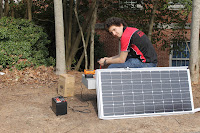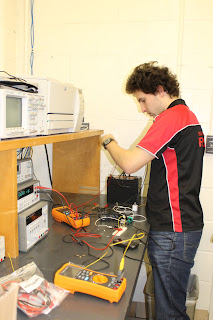Today we took to the lawn behind the prototyping lab to test the output of our solar panel under good conditions. It was bright and sunny, and between about 4 P.M. and 5 P.M. we took measurements of current and voltage. It was bright and sunny, and we saw the highest current we've drawn thus far out of our solar panel: 5.8 amps. The solar panel is rated at an optimum operating current of 5.29 amps, and our range was about 3 amps to 5.8 over the hour.
 |
| Whoo! Amperes! |
Connecting a load, we charged Julian's and my phones, drawing 230 milliamps to charge my phone on its own (a Samsung U450 Intensity) and 660 milliamps for the two phones (Julian's is an iPhone 4S) charging together. We're still a little unsure as to the prioritization of load v. battery charging when a load is connected in parallel to the battery. In this case, the current through the battery decreased by the amount of current through the two phones (as expected) but it's unclear whether the phones drew the current they wanted (the phones draw about 660 milliamps charging from a wall anyways) or if the battery in the circuit would decrease the current flow to the load if they tried to draw more current. Continuing with this project, we're trying to figure out ways to direct the current flow between the two charging options in order to optimize use.
1. The PWM5 is the solar charge controller for us. The CMP12, for the third time in a row, failed to yield any current drawn out of the solar panel, despite the sun being out and strong. Given that we've been working in a relatively stable environment (the engineering quad doesn't get too crazy), we have no interest in risking inconsistency with our node. The PWM5 has been working well and consistently; it's also sealed very well so dust and water don't pose a problem. The CMP12 has lots of holes in its interface that could allow dust in, and it's many components could fail fairly easily with exposure to dust. Our only concern with the PWM5: it is rated at a maximum of 6 amps. Today, we saw a current of 5.8 amps drawn from the solar panel, and it was late in the afternoon and not the strongest sunlight that we'll see. We're trying to get in touch with the manufacturer of the PWM5 to see if they really mean that you can only run 6 amps through it.
Maximum current aside, we're considering including some LED-type indicator for the current leaving the solar panel (so operators can know if they have a strong current and could use the time to charge phones, run lights, and charge the battery, or if they should prioritize charging just the battery) and for the voltage across the battery (charge percent of battery). This will allow for maximizing efficiency and preventing users from running out of battery power in the middle of the night without being aware of the low level of the battery.
2. If one of the 36 mini squares on the face of the panel (see picture below: there are four rows of nine squares clearly visible) has a significant part of its area in shadow, the current coming out of the solar panel drops considerably. With a current of 5.2 Amps, covering 1 square dropped the current to 1.4 Amps. A few minutes later, covering 2 squares dropped a 4.9 Amp current to .8 Amps.
This seems to indicate that each of the squares on the face are connected in series, so that blocking sunlight to any single square will impact the total current by more than linearly proportional to the blocked area. A hypothesis is that a certain amount frequency or intensity of light is needed to activate the semiconductor to allow any current to flow regardless of that particular cell contributing to current output. This is a wonderful thing to have discovered before any attempt to install the solar panel and be thwarted by a single ill-placed branch.
Moving Forward:
Our next step is to work on the box. We feel confident in our panel itself and in our choice of the PWM5 as our solar charge controller. So coming soon: putting these phone charging circuits into action!


















